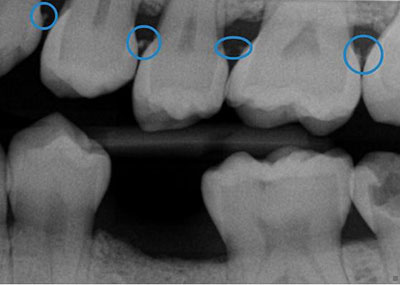“My last dentist told me I have gum disease and I need a deep cleaning, but my teeth don’t hurt.” Why fix something that doesn’t hurt?
Health problems come in two different varieties: the kind that you become aware of because it hurts, and the kinds that don’t provoke any symptoms until the disease has progressed to a severe state. If someone were to break their arm, they would know right away something is wrong because of the pain. Gum disease is not like that; it is more like having diabetes. Your doctor diagnoses it based on certain tests, and helps you manage it so that it does not progress.
Gum disease, or periodontitis, is diagnosed by evaluating x-rays for the loss of the bone that holds the teeth in place, and by doing a clinical exam to evaluate if the gums are inflamed and/or bleeding. Both parts of the exam are necessary to come to a diagnosis; neither one on it’s own provides enough information to form a diagnosis or a treatment plan.

The straight line in the picture above shows where the bone level should be in a healthy patient. The wavy line shows where the bone actually is. The black spaces in between show the areas where bone has been lost.
Sometimes people have xrays that look like the picture above but they do not need a deep cleaning. This happens when they have had gum disease in the past, and have already suffered some bone loss, but have received treatment and are now stable. The bone does not grow back, but as long as the gums are not inflamed, we know that they do not have active gum disease.

Other times, the bone loss is minor but there is heavy tartar buildup underneath the gums which causes them to be inflamed and bleed. This would be the early stages of gum disease and would be treated with a deep cleaning.
Treatment
Gum disease is treated with a deep cleaning. If a deep cleaning does not stabilize the disease, a second round of deep cleaning may be done, or gum surgery may be necessary. Click here to read more about the difference between a deep cleaning and a regular cleaning.
Early intervention with gum disease is critical because it is not reversible.Treatment is focused on preventing further damage, and does not bring back the bone that has already been lost.
Prevention of Gum Disease
Gum disease can be prevented. The two most important factors are flossing regularly with the proper technique, and regular dental visits every 6 months (or more frequently as determined by your dentist) to remove the plaque and tartar that accumulates even with good home care.


